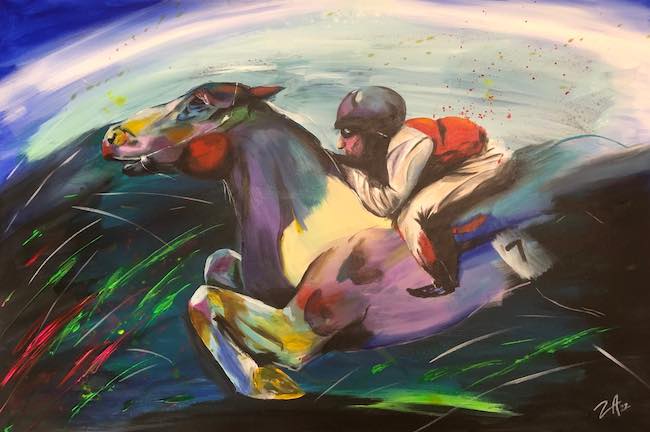Alcuni artisti contemporanei si spingono nell’esplorazione di tutto ciò che appartiene al complesso e sfaccettato vivere attuale, vanno a indagare tutto ciò che esiste nell’interiorità ma che fa fatica ad affiorare perché soffocato tra le pieghe di una quotidianità troppo veloce, troppo opprimente per permettere alle sensazioni di esprimersi liberamente; questo tipo di analisi tende spesso a emergere all’interno degli incalzanti ritmi cittadini da cui spesso l’artista si astrae oppure in cui si immerge per poi distaccarsene attraverso un linguaggio pittorico che gli permetta di valicare il confine tra ciò che imbavaglia l’essere umano e ciò che esiste oltre i limiti. Il protagonista di oggi invece sceglie di narrare e descrivere la natura con un suo personale stile pittorico frutto della fusione di movimenti artistici del passato.
Agli inizi del Ventesimo secolo, per la precisione nei primi due decenni, si delinearono correnti pittoriche che da un lato riprendevano le intuizioni delle avanguardie di fine Ottocento, dall’altro tendevano a trovare nuove soluzioni stilistiche per distaccarsi da tutto ciò che era stata la pittura precedente, troppo attenta alla forma estetica, alla descrizione della realtà osservata senza approfondirne concetti e significati. Il Futurismo si avvalse delle ricerche sulla frammentazione del tratto pittorico usato per infondere alle tele una maggiore attinenza alla realtà e alla luminosità, compiute dal Puntinismo prima e dal Divisionismo poi, laddove il secondo ricercava anche la dinamicità della pennellata; partendo da quelle elaborazioni teoriche il gruppo fondato da Filippo Tommaso Marinetti ampliò la scomposizione a figure più grandi e definite, sovrapponendole e replicandole per infondere alle opere il senso di movimento e velocità affine alle linee guida pittoriche del movimento che dovevano rappresentare la rapidità dei tempi, il susseguirsi delle innovazioni tecnologiche proiettate verso un nuovo futuro. Dunque non erano più le pennellate a dare il senso di movimento bensì le linee e l’immagine che venivano scomposte per infondere nell’osservazione l’illusione ottica del moto costante, dello spostamento in avanti del visibile. Diversamente dal Futurismo, il Surrealismo, a suo modo altrettanto rivoluzionario, rimase invece prevalentemente legato alla realtà osservata pur decontestualizzandola completamente, perché l’analisi che intendeva compiere era quella all’interno dell’inconscio, del mondo onirico spesso affollato dagli incubi in cui l’essere umano del tempo si trovava coinvolto, a causa delle atrocità viste e vissute durante la prima guerra mondiale, e anche per una maggiore conoscenza e attenzione al mondo interiore e psicologico dove si nascondevano tutte le ansie, le paure, le angosce controllate nella quotidianità attraverso la mente razionale. I mondi paralleli di Salvador Dalì e di René Magritte, sebbene in maniera differente, ebbero il potere di scuotere le coscienze e scandalizzare, soprattutto nel caso di Dalì, i benpensanti dell’epoca, inducendo l’osservatore a riflettere su se stesso e sulle sue inconfessate inquietudini. L’artista di origini torinesi Andrea Zannella, ormai da anni residente in Val d’Aosta, compie una sintesi tra i due movimenti del Novecento adeguandoli a quello che per lui è una condizione imprescindibile per la sua pittura ma anche del suo modo di vivere, cioè l’osservazione della natura intorno a sé.
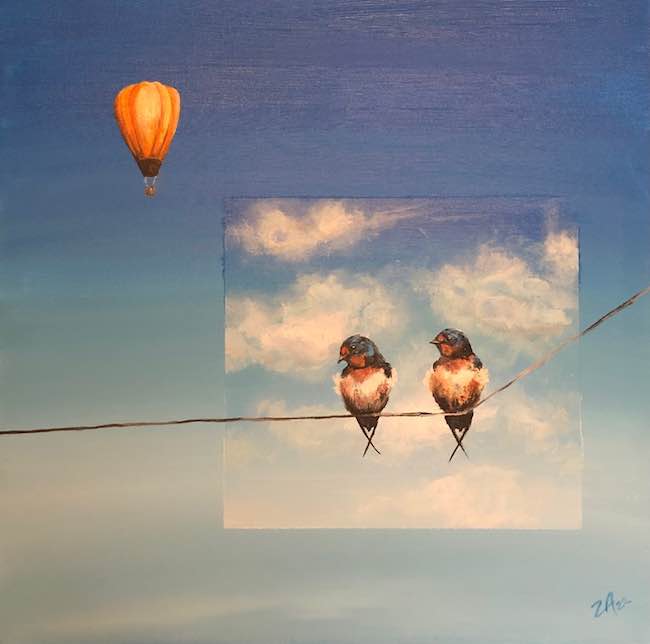
E lo fa sia attraverso l’arte, a cui si riavvicina dopo molti anni in cui ha lasciato che il suo impulso espressivo restasse latente e maturasse fino al punto di non poter più rimanere inascoltato, che con la fotografia naturalista che lo pone in una posizione di lenta osservazione di tutto ciò che appartiene al luogo in cui ha scelto di vivere, le montagne valdostane, per attendere quello scatto in cui tutto è perfettamente allineato, dove il movimento si fissa nel piccolo frangente che il suo sguardo decide sia il più conforme a ciò che stava osservando.
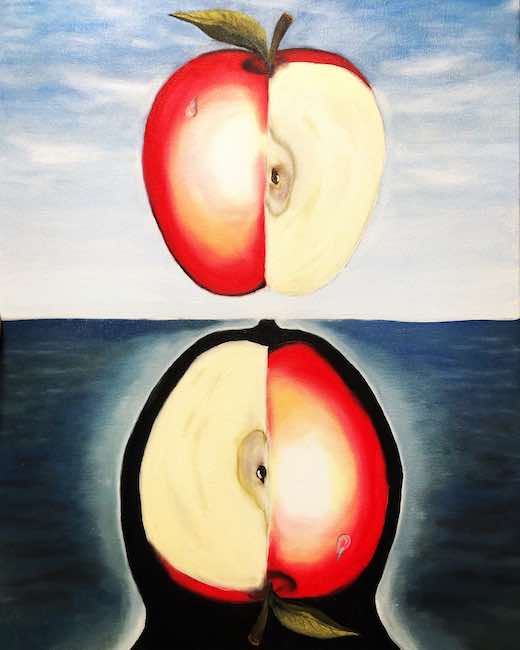
Tra la realtà della fotografia e l’impulsività della pittura però l’immagine si trasforma, viene filtrata dalla sua emotività, dalle sensazioni ricevute nella fase di ricerca nei confronti della bellezza intorno a sé, e tende pertanto verso una irrealtà appena percepibile, un emergere degli animali ritratti quasi come se si trovassero in una dimensione quantica da cui provengono materializzandosi sulla tela e cominciando subito dopo a correre verso una altro luogo, un altro punto in cui rientrare e così via, in un circolo perpetuo in cui tutto si muove e tutto scorre. La sua tecnica pittorica si avvale di linee più o meno nitide che infondono nell’osservatore quella sensazione di velocità tanto cara al Futurismo sebbene in Zannella non esista la scomposizione e rifrazione dell’immagine piuttosto una descrizione realistica nei tratti accompagnata dal moto energetico di ciò che circonda il soggetto.
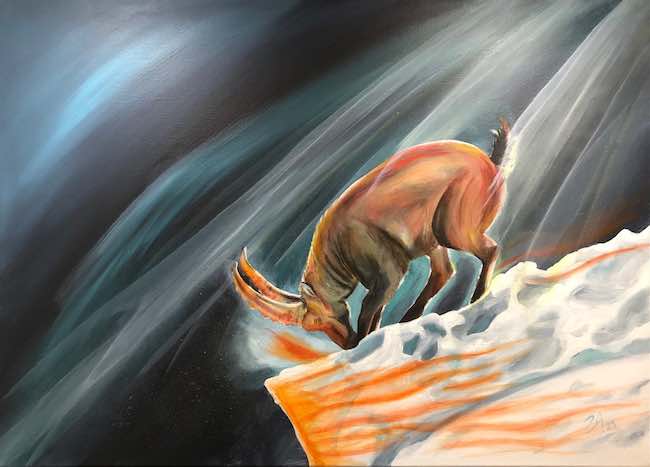
Perché la natura non è mai statica, respira e vive secondo i suoi ritmi più o meno accelerati sulla base del momento colto dallo sguardo; la descrizione dei cavalli, delle aquile, delle capre è tanto reale quanto innaturali appaiono i colori che l’artista utilizza per descriverli, mentre gli sfondi sembrano circondare i soggetti come se appartenessero a una dimensione incorporea, spirituale che accoglie l’elevazione di tutto ciò che rientra in quel ciclo spontaneo e naturale. Pertanto la gamma cromatica tende verso l’Espressionismo, funzionale però in questo caso ad accompagnare quel movimento che Zannella vuole raccontare in quanto essenza stessa di tutto ciò che circonda l’essere umano, malgrado il susseguirsi rapido del vivere della natura sia ben differente da quello alienante delle realtà cittadine dove il contatto con il mondo incontaminato è lontano, quasi dimenticato.
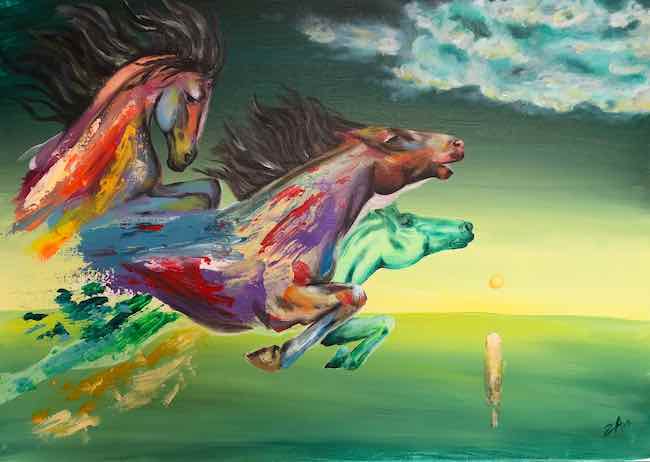
Il dipinto La corsa degli spiriti liberi appare come una metafora proprio in virtù di quell’inconsistenza di una parte del corpo dei cavalli che irrompono sulla tela come se provenissero da un’altra dimensione, interpretando per immagini quell’anima spesso ribelle che non si piega alle convenzioni, che non si lascia arrestare nella sua corsa verso l’evoluzione e la libertà; le pennellate nitide e definite sottolineano il moto degli animali, quella corsa al galoppo che sottolinea l’anima selvaggia di purosangue in grado di lanciarsi verso sfide, verso territori inesplorati, verso direzioni impensate proprio in virtù del loro indomito coraggio.
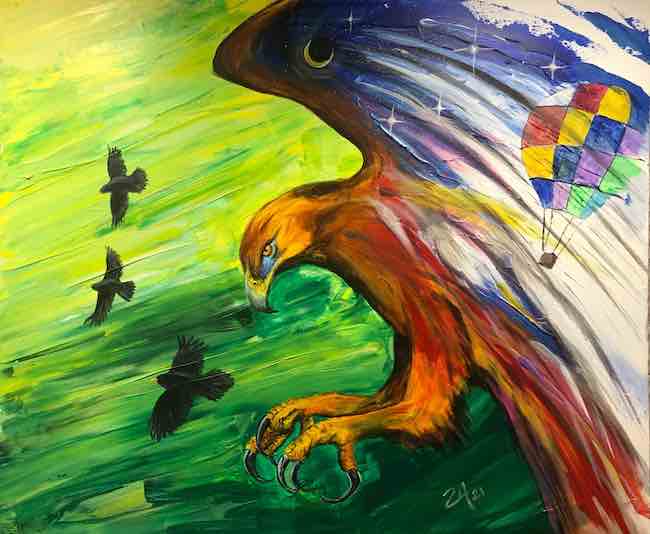
Nella tela Le ali della creazione invece l’aquila, simbolo di potenza e di vittoria, sta planando verso un nuovo terreno, quello in cui portare il nuovo, quella salvezza che troppo spesso l’essere umano speri arrivi dall’esterno dimenticando che è proprio dentro se stesso che può cercare la forza e la determinazione per trovare una via d’uscita. La creazione citata nel titolo può pertanto essere interpretata come una nuova nascita, il superamento attraverso il coraggio di oltrepassare le difficoltà che ingabbiavano impedendo di perseguire i veri obiettivi, quelli più importanti, quelli non facili da raggiungere eppure indispensabili per la felicità. In quest’opera è la densità delle pennellate a dare il senso del movimento, di quel volo planare effettuato dall’aquila e che rappresenta, come evocato dalla mongolfiera inserita nella sua ala, un passo verso la libertà di essere e di perseguire le mete importanti, quelle suggerite dall’anima.
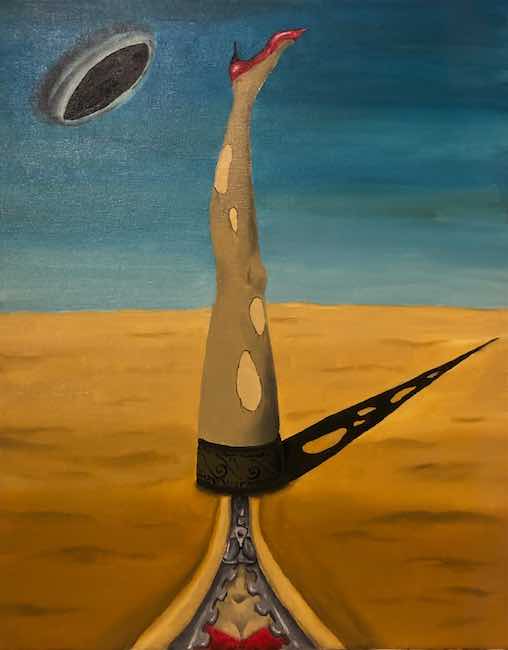
Il lato più surrealista di Andrea Zannella, quello in cui emerge la sua indagine nei confronti delle realtà improbabili ma in cui tutto può sembrare reale tanto quanto l’osservato quotidiano, fuoriesce dall’opera Murder in the desert, dove una gamba femminile rappresenta il concetto del soffocamento della personalità umana, nel caso specifico della donna, che sembra messa in silenzio e mortificata nelle sue pulsioni naturali da quella chiusura lampo posta sulla superficie desertica, costituente dunque l’aridità che si concretizza a causa della mancanza di libertà di esprimersi, e trasformata in memento di ciò che è stata in passato in virtù di quell’arto che si erge come una torre inanimata mentre un foro di osservazione rappresenta il controllo che ancora in molte culture l’uomo sente il diritto di poter esercitare.
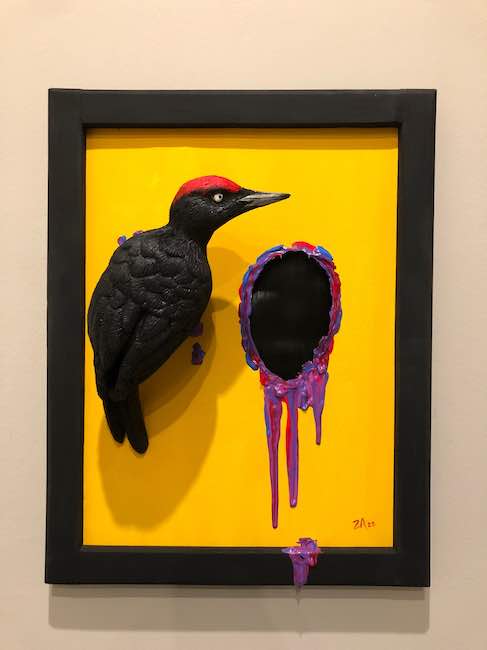
Negli ultimi tempi Andrea Zannella si è appassionato alla scultura su legno, sempre legata al mondo animale, attraverso la quale dà vita a pittosculture in cui l’elemento surrealista continua a manifestarsi, quasi come se davanti a una maggiore concretezza della materia si incentivasse la tendenza alla sua riflessione, la sua ricerca di un concetto su cui meditare proprio attraverso la natura, assoluta protagonista della sua arte e della sua quotidianità. Andrea Zannella, formatosi da autodidatta, espone regolarmente in mostre collettive e personali in Italia ricevendo ottimi consensi dall’affascinato pubblico e dagli addetti ai lavori.
ANDREA ZANNELLA-CONTATTI
Email: andreazannella84@tiscali.it
Sito web: https://andreazannella.com
Facebook: https://www.facebook.com/andrea.zannella.7
Instagram: https://www.instagram.com/zannella_andrea/
Nature interpreted by Andrea Zannella, between constant movement and surreal parallel realities
Some contemporary artists go out of their way to explore everything that belongs to today’s complex and multifaceted way of life, to investigate everything that exists in the inner world but struggles to surface because it is suffocated in the folds of a daily routine that is too fast-paced, too oppressive to allow sensations to express themselves freely; this type of analysis often tends to emerge within the pressing rhythms of the city, from which the artist often abstracts himself, or into which he immerses in order to then detach through a pictorial language that allows him to cross the border between what gags the human being and what exists beyond the limits. Today’s protagonist, on the other hand, chooses to narrate and describe nature with his own style of painting, the result of a fusion of artistic movements from the past.
At the beginning of the 20th century, in the first two decades to be precise, emerged pictorial currents that on the one hand took up the intuitions of the late 19th century avant-gardes, and on the other tended to find new stylistic solutions to break away from all that patingin had been before, which was too attentive to aesthetic form, to the description of observed reality without delving into its concepts and meanings. Futurism availed itself of the research on the fragmentation of the pictorial stroke used to infuse canvases with a greater relevance to reality and luminosity, carried out first by Pointillism and then by Divisionism, where the latter also sought the dynamism of the brushstroke; starting from those theoretical elaborations, the group founded by Filippo Tommaso Marinetti extended Divisionism to larger and more defined figures, superimposing and replicating them in order to infuse the artworks with a sense of movement and speead akin to the pictorial guidelines of movement that were meant to represent the rapidity of the times, the succession of technological innovations projected towards a new future. So it was no longer the brushstrokes that gave the sense of movement but the lines and the image that were broken up to instil in the viewer the optical illusion of constant motion, of the forward shift of the visible. Unlike Futurism, Surrealism, which in its own way was just as revolutionary, remained predominantly tied to the observed reality while completely decontextualising it, because the analysis it intended to carry out was that within the unconscious, the dream world often crowded with the nightmares in which the human being of the time found himself involved, due to the atrocities seen and experienced during the First World War, and also for greater knowledge and attention to the inner and psychological world where all the anxieties, fears and anguishes controlled in everyday life through the rational mind were hidden. The parallel worlds of Salvador Dali and René Magritte, albeit in different ways, had the power to shake consciences and scandalise, especially in Dali’s case, the well-wishers of the time, inducing the observer to reflect on himself and his unconfessed anxieties.
The Turin-born artist Andrea Zannella, who has been living in Val d’Aosta for many years, makes a synthesis of the two 20th century movements by adapting them to what for him is an essential condition for his painting but also for his way of life, namely observation of the nature around him. And he does this both through art, to which he returned after many years in which he had allowed his expressive impulse to remain latent and mature to the point that it could no longer go unheeded, and through naturalist photography, which places him in a position of slow observation of everything that belongs to the place where he has chosen to live, the mountains of Valle d’Aosta, to wait for that shot in which everything is perfectly aligned, where movement is fixed in the small juncture that his gaze decides is the most in keeping with what he was observing. Between the reality of photography and the impulsiveness of painting, however, the image is transformed, it is filtered by his emotionality, by the sensations received in the phase of research into the beauty around him, and thus tends towards a barely perceptible unreality, an emergence of the portrayed animals almost as if they were in a quantum dimension from which they come, materialising on the canvas and immediately beginning to run towards another place, another point to return to and so on, in a perpetual circle in which everything moves and everything flows.
His painting technique makes use of more or less sharp lines that instil in the observer that sensation of speed so dear to Futurism, although in Zannella there is no decomposition and refraction of the image rather a realistic description in the strokes accompanied by the energetic motion of what surrounds the subject. Because nature is never static, it breathes and lives according to its more or less accelerated rhythms on the basis of the moment captured by the gaze; the description of horses, eagles, goats is as real as the colours the artist uses to describe them appear unnatural, while the backgrounds seem to surround the subjects as if they belonged to an incorporeal, spiritual dimension that welcomes the elevation of everything that is part of that spontaneous and natural cycle. Therefore, the chromatic range tends towards Expressionism, functional in this case, however, to accompany that movement that Zannella wants to narrate as the very essence of everything that surrounds the human being, even though the rapid succession of life in nature is quite different from the alienating one of city realities where contact with the uncontaminated world is distant, almost forgotten.
The painting The Race of the Free Spirits appears as a metaphor precisely because of that inconsistency of a part of the horses’ body that bursts onto the canvas as if from another dimension, interpreting in images that often rebellious soul that does not bend to convention, that does not allow itself to be stopped in its race towards evolution and freedom; the sharp, well-defined brushstrokes emphasise the movement of the animals, that galloping race that underlines the wild soul of thoroughbreds capable of launching themselves towards challenges, towards unexplored territories, towards unthought-of directions precisely by virtue of their indomitable courage. In the canvas The Wings of Creation, on the other hand, the eagle, symbol of power and victory, is gliding towards a new terrain, one in which to bring the new, that salvation that all too often human beings hope will come from outside, forgetting that it is within themselves that they can look for strength and determination to find a way out. The creation mentioned in the title can therefore be interpreted as a new birth, the overcoming through courage of transcend the difficulties that caged one from pursuing the real goals, the most important ones, the ones that are not easy to achieve yet indispensable for happiness. In this work, it is the density of the brushstrokes that gives the sense of movement, of that gliding flight performed by the eagle and which represents, as evoked by the hot air balloon inserted in its wing, a step towards the freedom to be and to pursue the important goals, those suggested by the soul. The more surrealist side of Andrea Zannella, the one in which his investigation into improbable realities emerges, but in which everything can seem as real as the everyday observed, emerges from the painting Murder in the desert, where a female leg represents the concept of the suffocation of the human personality, in the specific case of the woman who seems silenced and mortified in her natural impulses by that zip placed on the desert surface, thus constituting the barrenness that is realised due to the lack of freedom to express herself, and transformed into a memento of what she has been in the past by virtue of that limb that stands like an inanimate tower while an observation hole represents the control that in many cultures man still feels the right to exercise. In recent times, Andrea Zannella hab become passionate about wood sculpture, again linked to the animal world, through which he gives life to pictosculptures in which the surrealist element continues to manifest itself, almost as if the greater concreteness of the material stimulated his tendency towards reflection, his search for a concept on which to meditate precisely through nature, the absolute protagonist of his art and his everyday life. Andrea Zannella, trained as a self-taught artist, regularly exhibits in group and solo shows in Italy, receiving great acclaim from the fascinated public and insiders.


